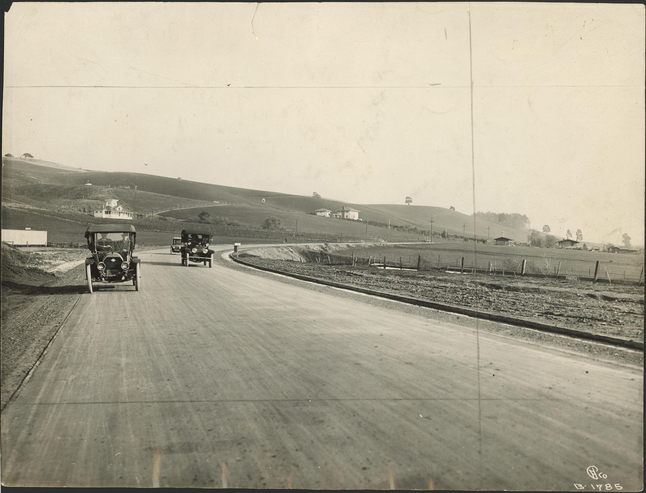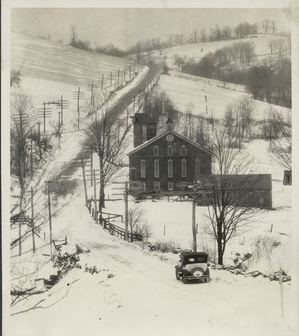Hatcher Library exhibit tells story of America's Main Street, the Lincoln Highway
Note: The library's name has been corrected.

“Lincoln Highway (formerly Foothill Blvd) near Hayward, California in Alameda County”
courtesy of the University of Michigan Transportation History Collection
The exhibit commemorates the centennial of this famed U.S. highway, which once stretched from New York City’s Times Square to San Francisco’s Lincoln Park.
The Lincoln Highway’s 3,400 “scenic” miles, says Kathleen Dow, Head of the Archives Unit and curator of the Transportation History Collection at the U-M Library, was “one of America’s first paved transcontinental highways.”
It was a slog to travel outside urban areas even as late as the second decade of the 20th century. Inner-city driving wasn’t that much better — there were merely the rudiments of roadways within cities themselves — but there was simply no infrastructure to go across the country.
You might as well have ventured forth in a covered wagon.
“By 1913, Ford Motor Company and dozens of smaller manufacturers were building more affordable cars so they would be within reach of the common man,” says Dow in her gallery statement, “but lack of roads made travel difficult. With no government support, Indianapolis-based entrepreneur Carl Fisher formed and led the Lincoln Highway Association, which was made up of representatives from the automobile, tire, and cement industries. Their goal was to plan, fund, construct, and promote (one of the first) coast-to-coast highways.”
Formally dedicated on Oct. 31, 1913, this initial automobile road across the continent opened commercial opportunities for the states, cities, and towns it passed through. So much so, it was given the nickname of “The Main Street across America.” As such, one of the more interesting aspects of this exhibit is precisely the historic record of this “main street across America” because the Audubon space is filled with just this kind of memorabilia.

“Packard in snow-covered valley west of Stoystown, Pennsylvania. 1924”
courtesy of the University of Michigan Transportation History Collection
“Association members attacked the complex problem of mapping the road, getting right-of-way permissions and allowance to post markers along the route; convincing others to change the name of roads incorporated into the highway (and rerouting when the request was refused); and figuring out how to build a road through miles of desert, over mountain ranges, and through flood plains. They took photos along the proposed route, annotating them to help with decision-making, and more during construction.”
This sort of information is on display. It is, in fact, the most prominent feature of the exhibit.
Two very large, oversized posters dominate the Audubon’s wall shelves. The first is a 1913 “Appeal to Patriots” broadside sent as an address to the governors of all states — succinctly explaining the purpose behind the Lincoln Memorial Highway. And flanking this appeal is a “Proclamation of the Lincoln Highway” clarifying the proposition. These two massive documents set the agenda for “On the Road.”
As Dow points out, the men who planned the highway “were a combination of visionaries and flim-flam men.
“They were trying to build a quality road,” she says, “but they were also trying to expand their companies — they wanted to make a buck and have a good time. Donations poured in from building companies, suppliers and individual citizens.”
This is nowhere more apparent than an Aug. 11, 1913 letter on display written by Joseph Patrick Tumulty, secretary to President Woodrow Wilson, to Arthur Pardington, vice president of the Lincoln Highway Association. Tumulty’s letter, declining a certificate offered by the Lincoln Highway Association, speaks for the official record. Not noted, but also part of the historic record, is the fact that Wilson made a private contribution to the Lincoln Highway Association.
“On the Road” is good at illustrating the hardships and challenges that came with the highway’s construction. But as with the project organizers themselves, the exhibit is especially good at highlighting the association’s virtues. As such, a group of seven portrait black and white photographs is enough to allay concern about the association Board of Directors bona fides. Included in this group with Michigan connections are Lincoln Highway Association President Henry B. Joy (president of the Packard Motor Co.); Vice President Roy D. Chapin (chairman, Hudson Motor Car Co.); and Vice President-Secretary Austin Bement (Austin F. Bement Agency, Detroit). Each of these fellows has the ostensive rectitude one might seek in making a donation to what was essentially a first-of-its-kind project.
Also included are three leather-bound consecutive editions of “The Complete Road Guide of the Lincoln Highway”; a 1921 “Brief Account of the Eighth Year of Progress on the Lincoln Highway”; a 1925 Metro-Goldwyn “America’s First Trackless Road” brochure; and a 1935 scrapbook with reactions to “The Lincoln Highway: the Story of a Crusade that Made Transportation History” book published that same year.
Of special interest are 13 color postcards giving us a view of what America looked like at that time drawn from the highway route: “Donner Memorial Bridge and Donner Lake,” near Reno, Nev.; “Fifth Ave. through Clinton, IA”; (downtown) “Lincoln Highway,” Massillon, Ohio; and “Calhoun Street Bridge,” Trenton, NJ.
Toss in service coupons from “Lincoln Hi-Way Service Co.” from Upper Sandusky, Ohio; a “Lincoln Highway” cigar band taken from the Frankfort, IN National Cigar Co.; “Official Lincoln Highway Globe sticker” manufactured by Pittsburgh’s Macbeth-Evans Glass Co.; and even the sheet music to the “Lincoln Highway March, Two Step” by Harry J. Lincoln,” and the display is packed.
Dow notes, “When the road was finished in 1927, the Lincoln Highway Association was disbanded. (But) in 1992 it was revived by historians and highway buffs as a historical preservation group dedicated to preserving the remaining sections of the highway.”
This makes “On the Road” a fitting centennial celebration of one of the most influential nationwide projects that would ultimately define 20th century American life; as well as serve as a direct influence for the pivotal National Interstate and Defense Highways Act of 1956 that laid the foundation for today’s interstate highway system. It’s a legacy to remember.
“On the Road: Celebrating 100 Years of the Lincoln Highway” will continue through Aug. 29 at the University of Michigan Harlan Hatcher Graduate Library Room 100, Audubon Room, 913 S. University St. Exhibit hours are 8:30 a.m. to 7 p.m., Monday-Friday; 10 a.m. to 6 p.m., Saturday; and 2 to 7 p.m., Sunday. For information, call 734-764-0400.


Comments
Peggy Daub
Mon, Aug 5, 2013 : 1:50 p.m.
I think the Ypsilanti Lincoln Highway buff cited above was very involved and even loaned things to the exhibit. Most of the items come from the national Lincoln Highway Archive, which is in the Special Collections Library at UM. And the photos from that archive are online here: http://quod.lib.umich.edu/cgi/i/image/image-idx?c=linchigh&page=index
spg
Mon, Aug 5, 2013 : 1:51 a.m.
John, The president of the Lincoln Highway Association lives in Ypsilanti and is very active nationally regarding the preservation and History of the "LincWay". I hope that U of M contacted him regarding this, but it sounds like they may have not. Too bad as he is a walking dictionary of all things Lincoln Highway!
Leah Gunn
Sun, Aug 4, 2013 : 11:37 p.m.
Horace Hatcher? I believe that's HARLAN Hatcher, a former President of the Unicersity of Michigan.
Jonathan Blutarsky
Sun, Aug 4, 2013 : 10:29 p.m.
I wish A2DOTCOM would do more stories such as this.
Gorc
Sun, Aug 4, 2013 : 3:43 p.m.
Lincoln Highway also went through my hometown too, in the southern suburbs of Chicago. As a kid I never understood why the road had two names (Route 30 and Lincoln Hwy). In the mid 1970's my father explained to me the significants of Lincoln Highway and that it expanded from New York to California. Mr. Cantu...thanks for the memory and educating me with more facts and details.
Tano
Sun, Aug 4, 2013 : 4:43 p.m.
...the significance... ...it extended...
Dog Guy
Sun, Aug 4, 2013 : 2:21 p.m.
Thank you, Mr. Cantu, for another concise and entertaining review. Please continue to separate the mouse droppings from the pepper.
ScioReader
Sun, Aug 4, 2013 : 12:44 p.m.
The Lincoln Highway went through my hometown in NJ. When I was growing up in the '50s and '60s, we simply thought Lincoln Highway was just the road out of town. Years later I found out it went across the country. Who knew?